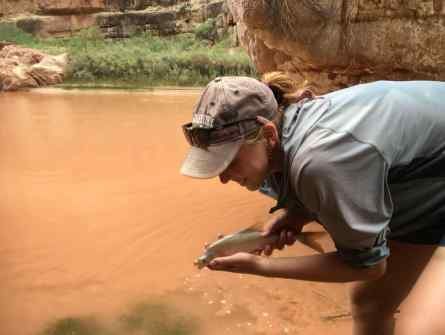Ever known someone who can’t see the forest for the trees? This week, we hear from a scientist who sees both: Dr. Andrew Sanchez-Meador, an assistant professor in the School of Forestry at Northern Arizona University. As the program director of biometrics in forest management within the Ecological Restoration Institute at the university, Sanchez-Meador studies the underlying structure, composition, and functions of forests and how to restore them after degradation.
Science Moab: How do the structures and functions of forests change?
Sanchez-Meador: In southwestern forest types—primarily pinyon-juniper ecosystems, ponderosa pine ecosystems, or maybe even mixed-conifer ecosystems—disturbances have often caused the change. Disturbances could include insect and disease outbreaks, changes in climate, fire, or maybe just some small-degree earthquake. Those disturbances are part of the ecosystem function, which works as part of a feedback loop with structure and composition.
For instance, if you have a forest of big ponderosa pines being invaded by alligator junipers, which are smaller trees, this represents a difference in structure. If a fire comes through, killing the alligator juniper, it’s changing both the structure and composition of the forest. Then, the new structure and composition changes understory fuels, flammability, all that type of stuff, which will alter function in the future. This describes the structure-composition-function feedback loop. After a disturbance, the ecosystem may not behave the way it was intended to but it provides insights into how we can restore those ecosystems and get them to function naturally again.
Science Moab: When you’re looking out into a forest, what would you label as degraded?
Sanchez-Meador: A degraded forest is one that has a structure, composition, and function outside of its natural conditions. So a ponderosa pine forest that historically would’ve had frequent low-severity fires that’s now experiencing infrequent high-severity fires — that would be a sign of degradation in that system. A mixed-conifer forest that historically experienced certain levels of insect and disease activity, and is now experiencing epidemic levels, would be a sign of degradation. So does a forest that historically had a large grass understory keeping soils in place and preventing erosion, that’s now experiencing such [erosion], would be another sign of degradation. So, degradation is indicated by these different lines of evidence suggesting that the forest is not behaving, or responding to disturbances, the way it evolved to do.
Science Moab: What does restoration look like in a forest?
Sanchez-Meador: It can really vary depending on the type of forest and the form of degradation. In the Southwest, for instance, in pinyon-juniper ecosystems, we have a lot of historical savannas, which would have been mainly grasslands with a few scattered trees. Many of these have had juniper species invade them in the absence of fire, and now have become dense forest, woodlands, or shrublands. In those ecosystems, restoration might be removing a lot of trees, and then adding fire back in on a really high frequency so that grassland conditions can be maintained. You’d then have the structure and the composition of a grassland, and therefore you’d have all the function of a grassland.
Science Moab: How about in a mixed-conifer forest?
Sanchez-Meador: The mixed-conifer type is viewed as a mosaic of warmer, drier sites intermixed with cooler, wetter sites. Historically, frequent fire would have burned in the drier areas at a low severity, then would move into the wetter areas and put itself out. It would have done that over and over and over again, and only in the warmest, driest years would fire have moved into the wetter areas and created a patchwork of high severity. Today, fire moves in and burns the whole thing, and we get large-scale high-severity fire because of changes in species composition and increases in fire-intolerant species. The restoration efforts here would be to reduce tree density and maybe try to change the structure by removing small trees. We would also want to favor, or even recruit, fire-tolerant species like ponderosa pine, Douglas fir, and southwestern white pine. So, we can change the structure and composition, but if we don’t reintroduce the primary disturbance—fire, in this system—then there’s no guarantee that we’re going to get all the functional benefits we’re seeking.
To learn more and listen to the rest of Andrew Sanchez-Meador’s interview, visit soundcloud.com/user-495802209/the-structure-and-function-of-forests. This interview has been edited for clarity.




